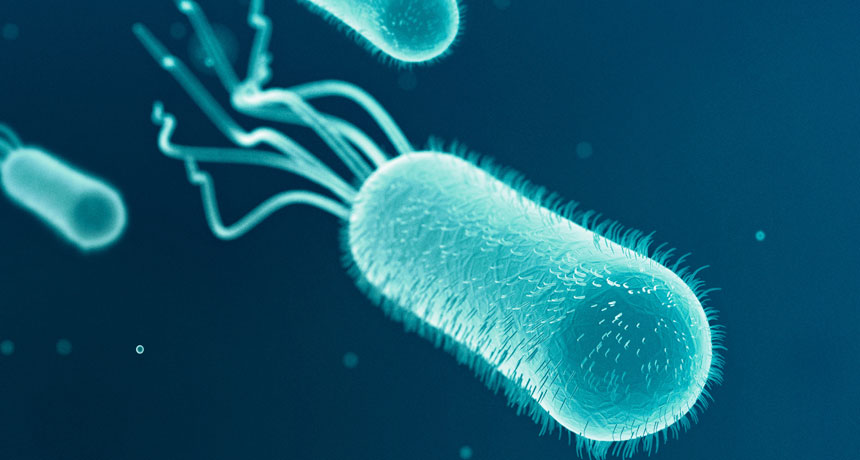Bacteria help water effortlessly go with the flow
With added microscopic cells, fluids flow as with no obvious resistance

E. coli, illustrated here, use their tail-like flagella to swim. A new study reveals that the bacteria’s synchronized swimming can eliminate a liquid’s resistance to flow.
© luismmolina / iStockphoto
Share this:
- Share via email (Opens in new window) Email
- Click to share on Facebook (Opens in new window) Facebook
- Click to share on X (Opens in new window) X
- Click to share on Pinterest (Opens in new window) Pinterest
- Click to share on Reddit (Opens in new window) Reddit
- Share to Google Classroom (Opens in new window) Google Classroom
- Click to print (Opens in new window) Print
By Andrew Grant
Water flows best when it’s chock-full of synchronized-swimming bacteria, a new experiment finds.
It may appear that water flows easily. After all, a stream of it flows a lot faster than, say, a stream of honey. But water doesn’t flow nearly as fast as liquid helium. Such a frigid liquid flows with almost no resistance. Indeed, it is said to have zero viscosity. (Viscosity is a measure of a fluid’s resistance to stress. It corresponds to the idea of how “thick” a liquid is.)
But now, by coaxing billions of cells to work together, researchers have made a small sample of a bacteria-laden water solution show no resistance to flow.
“The results are pretty compelling,” says Raymond Goldstein. He is a physicist at the University of Cambridge in England. The new study, he says, demonstrates that the motion of microbes can drive the large-scale behavior of liquids.
The new finding appears in the July 10 Physical Review Letters. Physicists Héctor Matías López and Harold Auradou at Paris-Sud University and their colleagues authored the new paper.
These researchers started with a small cup filled with water, nutrients and E. coli bacteria. There were enough nutrients to fuel the swimming of bacteria, but not enough energy to allow the microbes to divide. Then the physicists dipped a cylindrical probe into the cup. They slowly rotated the cup and measured the force of the twist, or torque, exerted by the solution on the probe.
A viscous fluid like honey would tug on and spin the probe. Water also would tug on the probe, just not as much. When infused with a strain of very active E. coli, however, the water solution exerted no torque on the probe. That indicates zero viscosity. In some trials, the viscosity actually became negative: The cup rotated counterclockwise. But the solution exerted a clockwise torque on the probe.
Before the cup spun, the bacteria had been swimming about randomly, Auradou says. But theoretical studies suggest that once the liquid starts to flow, the E. coli coordinate their motion. As the rod-shaped bacteria swim, they push water in front and behind themselves. Liquid fills in from the sides. That nudges neighboring bacteria closer together and causes them to line up and swim in a similar direction. The bacteria’s collective pushing increases the speed at which adjacent layers of water can rush past each other. That gives the solution a more efficient — and less viscous — flow.
The new finding may be especially useful in the lab. Tiny amounts of fluid can be difficult to analyze because samples can get stuck in micro-size passageways. Bacteria may help by ensuring that scientists can measure every last drop.
Power Words
(for more about Power Words, click here)
bacterium (plural bacteria) A single-celled organism. These dwell nearly everywhere on Earth, from the bottom of the sea to inside animals.
E. coli (short for Escherichia coli) A bacterium that researchers often use to study genetics. Some types of this microbe cause disease, but many other forms of it do not.
flagellum (plural flagella) A long, tapering appendage that some cells use for locomotion.
helium An inert gas that is the lightest member of the noble gas series. Helium can become a solid at -458 degrees Fahrenheit (-272 degrees Celsius).
microbe Short for microorganism. It’s a living thing that is too small to see with the unaided eye, including bacteria, some fungi and many other organisms such as amoebas. Most consist of a single cell.
microscopic An adjective for things too small to be seen by the unaided eye. It takes a microscope to view such tiny objects, such as bacteria or other one-celled organisms.
nutrients Vitamins, minerals, fats, carbohydrates and proteins needed by organisms to live, and which are extracted through the diet.
organism Any living thing, from elephants and plants to bacteria and other types of single-celled life.
physics The scientific study of the nature and properties of matter and energy. Classical physics is an explanation of the nature and properties of matter and energy that relies on descriptions such as Newton’s laws of motion. It’s an alternative to quantum physics in explaining the motions and behavior of matter. A scientist who works in that field is known as a physicist.
random Something that occurs haphazardly or without reason, based on no intention or purpose.
stress (in physics) Pressure or tension exerted on a material object.
theoretical An adjective for an analysis or assessment of something that based on pre-existing knowledge of how things behave. It is not based on experimental trials. Theoretical research tends to use math — usually performed by computers — to predict how or what will occur for some specified series of conditions. Experimental testing or observations of natural systems will then be needed to confirm what had been predicted.
torque A force that produces rotation, twisting or turning.
viscosity The measure of a fluid’s resistance to stress. Viscosity corresponds to the idea of how “thick” a liquid is. Honey is very viscous, for instance, while water has relatively low viscosity.
viscous The property of being thick, sticky and hard to pour. Molasses and maple syrup are two examples of viscous liquids.







